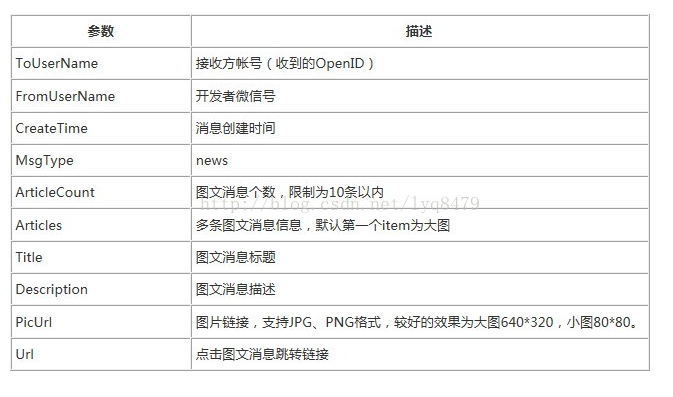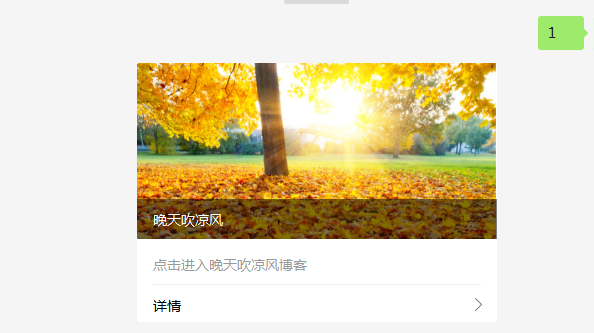Description of main parameters of graphic message
Through the official wechat message interface guide, you can see the introduction to the parameters of graphic message, as shown in the following figure:

From the above figure, we can see:
1. Limit the number of text messages to 10, that is, the value of ArticleCount in the text (limit the number of text messages to 10)
2. For text messages, the picture of the first text is displayed as a large picture, and the picture of other text is displayed as a small picture.
3. The first picture size is 640 * 320, and other pictures are 80 * 80
Let's start with:
Base class for request message:
import com.thoughtworks.xstream.annotations.XStreamAlias; import java.io.Serializable; /** * @author inchlifc */ public class BaseMessage implements Serializable { @XStreamAlias("ToUserName") @XStreamCDATA private String ToUserName; @XStreamAlias("FromUserName") @XStreamCDATA private String FromUserName; @XStreamAlias("CreateTime") private Long CreateTime; @XStreamAlias("MsgType") @XStreamCDATA private String MsgType; public BaseMessage() { super(); } public BaseMessage(String fromUserName, String toUserName) { super(); FromUserName = fromUserName; ToUserName = toUserName; CreateTime = System.currentTimeMillis(); } public String getToUserName() { return ToUserName; } public void setToUserName(String toUserName) { ToUserName = toUserName; } public String getFromUserName() { return FromUserName; } public void setFromUserName(String fromUserName) { FromUserName = fromUserName; } public Long getCreateTime() { return CreateTime; } public void setCreateTime(Long createTime) { CreateTime = createTime; } public String getMsgType() { return MsgType; } public void setMsgType(String msgType) { MsgType = msgType; } }
Text message class:
import com.thoughtworks.xstream.annotations.XStreamAlias; import java.util.List; @XStreamAlias("xml") public class ArticlesMessage extends BaseMessage { @XStreamAlias("ArticleCount") private int ArticleCount; @XStreamAlias("Articles") private List<ArticlesItem> Articles; public int getArticleCount() { return ArticleCount; } public void setArticleCount(int articleCount) { ArticleCount = articleCount; } public List<ArticlesItem> getArticles() { return Articles; } public void setArticles(List<ArticlesItem> articles) { Articles = articles; } }
Articles class in graphic message:
import com.thoughtworks.xstream.annotations.XStreamAlias;
import java.util.List;
@XStreamAlias("Articles")
public class Articles {
private List<ArticlesItem> Articles;
}
ArticlesItem class in graphic message:
import com.thoughtworks.xstream.annotations.XStreamAlias; import java.io.Serializable; @XStreamAlias("item") public class ArticlesItem implements Serializable { @XStreamAlias("Title") @XStreamCDATA private String Title; @XStreamAlias("Description") @XStreamCDATA private String Description; @XStreamAlias("PicUrl") @XStreamCDATA private String PicUrl; @XStreamAlias("Url") @XStreamCDATA private String Url; public String getTitle() { return Title; } public void setTitle(String title) { Title = title; } public String getDescription() { return Description; } public void setDescription(String description) { Description = description; } public String getPicUrl() { return PicUrl; } public void setPicUrl(String picUrl) { PicUrl = picUrl; } public String getUrl() { return Url; } public void setUrl(String url) { Url = url; } }
Implementation method of service layer:
Encapsulation method
/** * Get blog image message * * @param custermName * @param serverName * @param createTime * @return */ private ArticlesMessage getBlogMessage(String custermName, String serverName, Long createTime) { ArticlesMessage outputMsg = new ArticlesMessage(); outputMsg.setFromUserName(serverName); outputMsg.setToUserName(custermName); outputMsg.setCreateTime(createTime); outputMsg.setMsgType(MsgType.NEWS.getValue()); List<ArticlesItem> articles = new ArrayList<>(); ArticlesItem item1 = new ArticlesItem(); item1.setTitle("Cool breeze in the evening"); item1.setDescription("Click to enter the cool breeze blog"); item1.setPicUrl(WechatConstant.BASE_SERVER + "resources/images/wechat/a.png"); item1.setUrl("https://my.oschina.net/inchlifc/blog"); articles.add(item1); outputMsg.setArticles(articles); outputMsg.setArticleCount(articles.size()); return outputMsg; }
Judge that if the number 1 is input, the image and text message push will be returned
// Processing received messages ServletInputStream in = request.getInputStream(); // Convert POST stream to XStream object XStream xs = new XStream(); xs = SerializeXmlUtil.createXstream(); XStream.setupDefaultSecurity(xs); xs.allowTypes(new Class[]{TextMessage.class, InputMessage.class, ArticlesMessage.class}); xs.processAnnotations(InputMessage.class); xs.processAnnotations(ArticlesMessage.class); xs.processAnnotations(ImageMessage.class); // Map the xml node data under the specified node to an object xs.alias("xml", InputMessage.class); // Convert stream to string StringBuilder xmlMsg = new StringBuilder(); byte[] b = new byte[4096]; for (int n; (n = in.read(b)) != -1; ) { xmlMsg.append(new String(b, 0, n, "UTF-8")); } logger.info("Receive message====" + xmlMsg.toString()); // Converting xml content to InputMessage objects InputMessage inputMsg = (InputMessage) xs.fromXML(xmlMsg.toString()); // Server side String servername = inputMsg.getToUserName(); // Client String custermname = inputMsg.getFromUserName(); // Receiving time long createTime = inputMsg.getCreateTime(); // Return time Long returnTime = Calendar.getInstance().getTimeInMillis() / 1000; //Take over text content String content = inputMsg.getContent(); // Get message type String msgType = inputMsg.getMsgType(); if (MsgType.TEXT.getValue().equals(msgType)) { //Enter 1 push blog information if ("1".equals(content)) { logger.info("Received text1"); ArticlesMessage outputMsg = getBlogMessage(custermname, servername, returnTime); logger.info("Return to blog image message===" + xs.toXML(outputMsg)); response.getWriter().write(xs.toXML(outputMsg)); } }
Operation result:
